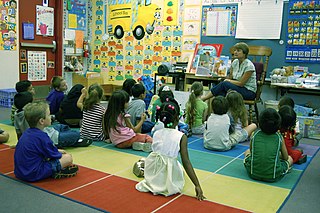
Developmental psychology is the scientific study of how and why humans grow, change, and adapt across the course of their lives. Originally concerned with infants and children, the field has expanded to include adolescence, adult development, aging, and the entire lifespan. Developmental psychologists aim to explain how thinking, feeling, and behaviors change throughout life. This field examines change across three major dimensions, which are physical development, cognitive development, and social emotional development. Within these three dimensions are a broad range of topics including motor skills, executive functions, moral understanding, language acquisition, social change, personality, emotional development, self-concept, and identity formation.

Lev Semyonovich Vygotsky was a Soviet psychologist, best known for his work on psychological development in children and creating the framework known as cultural-historical activity theory.

In sociology, a peer group is both a social group and a primary group of people who have similar interests (homophily), age, background, or social status. The members of this group are likely to influence the person's beliefs and behaviour.

Imaginary friends are a psychological and social phenomenon where a friendship or other interpersonal relationship takes place in the imagination rather than physical reality.

Early childhood education (ECE), also known as nursery education, is a branch of education theory that relates to the teaching of children from birth up to the age of eight. Traditionally, this is up to the equivalent of third grade. ECE is described as an important period in child development.
The psychology of learning refers to theories and research on how individuals learn. There are many theories of learning. Some take on a more behaviorist approach which focuses on inputs and reinforcements. Other approaches, such as theories related to neuroscience and social cognition, focus more on how the brain's organization and structure influence learning. Some psychological approaches, such as social constructivism, focus more on one's interaction with the environment and with others. Other theories, such as those related to motivation, like the growth mindset, focus more on individuals' perceptions of ability.
Cognitive development is a field of study in neuroscience and psychology focusing on a child's development in terms of information processing, conceptual resources, perceptual skill, language learning, and other aspects of the developed adult brain and cognitive psychology. Qualitative differences between how a child processes their waking experience and how an adult processes their waking experience are acknowledged. Cognitive development is defined as the emergence of the ability to consciously cognize, understand, and articulate their understanding in adult terms. Cognitive development is how a person perceives, thinks, and gains understanding of their world through the relations of genetic and learning factors. There are four stages to cognitive information development. They are, reasoning, intelligence, language, and memory. These stages start when the baby is about 18 months old, they play with toys, listen to their parents speak, they watch tv, anything that catches their attention helps build their cognitive development.
Relational aggression, alternative aggression, or relational bullying is a type of aggression in which harm is caused by damaging someone's relationships or social status.

The zone of proximal development (ZPD) is a concept in educational psychology. It represents the space between what a learner is capable of doing unsupported and what the learner cannot do even with support. It is the range where the learner is able to perform, but only with support from a teacher or a peer with more knowledge or expertise. The concept was introduced, but not fully developed, by psychologist Lev Vygotsky (1896–1934) during the last three years of his life. Vygotsky argued that a child gets involved in a dialogue with the "more knowledgeable other" such as a peer or an adult and gradually, through social interaction and sense-making, develops the ability to solve problems independently and do certain tasks without help. Following Vygotsky, some educators believe that the role of education is to give children experiences that are within their zones of proximal development, thereby encouraging and advancing their individual learning such as skills and strategies.
Childhood gender nonconformity (CGN) is a phenomenon in which prepubescent children do not conform to expected gender-related sociological or psychological patterns, or identify with the opposite sex/gender. Typical behavior among those who exhibit the phenomenon includes but is not limited to a propensity to cross-dress, refusal to take part in activities conventionally thought suitable for the gender and the exclusive choice of play-mates of the opposite sex.
Private speech is speech spoken to oneself for communication, self-guidance, and self-regulation of behaviour. It is between the ages of two and seven that children can be observed engaging in private speech. Although it is audible, it is neither intended for nor directed at others. Private speech was first studied by Lev Vygotsky (1934/1986) and Jean Piaget (1959); in the past 30 years private speech has received renewed attention from researchers. Researchers have noted a positive correlation between children's use of private speech and their task performance and achievement, a fact also noted previously by Vygotsky. It is when children begin school that their use of private speech decreases and "goes underground".

Play is a range of intrinsically motivated activities done for recreational pleasure and enjoyment. Play is commonly associated with children and juvenile-level activities, but may be engaged in at any life stage, and among other higher-functioning animals as well, most notably mammals and birds.
Learning through play is a term used in education and psychology to describe how a child can learn to make sense of the world around them. Through play children can develop social and cognitive skills, mature emotionally, and gain the self-confidence required to engage in new experiences and environments.
Mildred Bernice Parten Newhall was an American sociologist, a researcher at University of Minnesota's Institute of Child Development.
Stages of play is a theory and classification of children's participation in play developed by Mildred Parten Newhall in her 1929 dissertation. Parten observed American preschool age children at free play.
In the framework of the Cultural-Historical Activity Theory (CHAT) the leading activity is the activity, or cooperative human action, which plays the most essential role in child development during a given developmental period. Although many activities may play a role in a child's development at any given time, the leading activity is theorized to be the type of social interaction that is most beneficial in terms of producing major developmental accomplishments, and preparing the child for the next period of development. Through engaging in leading activities, a child develops a wide range of capabilities, including emotional connection with others, motivation to engage in more complex social activities, the creation of new cognitive abilities, and the restructuring of old ones.

Kindergarten readiness refers to the developmental domains that contribute to children's ability to adapt to the kindergarten classroom, which is often a new and unfamiliar environment. There is no single agreed upon definition of Kindergarten readiness. The domains often included in the definition comprise: academic skills, social-emotional development, and physical development. In addition to these competencies, the child's environment and opportunities for learning should also be considered. This includes the child's home environment and their interactions with teachers and peers.
Maladjustment is a term used in psychology to refer the "inability to react successfully and satisfactorily to the demand of one's environment". The term maladjustment can be refer to a wide range of social, biological and psychological conditions.
Social emotional development represents a specific domain of child development. It is a gradual, integrative process through which children acquire the capacity to understand, experience, express, and manage emotions and to develop meaningful relationships with others. As such, social emotional development encompasses a large range of skills and constructs, including, but not limited to: self-awareness, joint attention, play, theory of mind, self-esteem, emotion regulation, friendships, and identity development.
Adam Winsler is a developmental psychologist known for his research on early child development, private speech, and benefits of arts education. Winsler is Professor of Applied Developmental Psychology at George Mason University.








